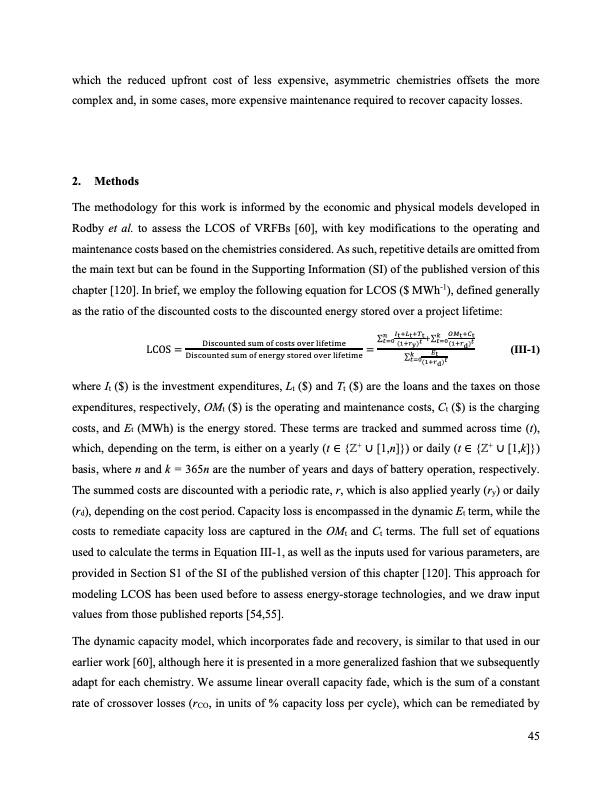
PDF Publication Title:
Text from PDF Page: 045
which the reduced upfront cost of less expensive, asymmetric chemistries offsets the more complex and, in some cases, more expensive maintenance required to recover capacity losses. 2. Methods The methodology for this work is informed by the economic and physical models developed in Rodby et al. to assess the LCOS of VRFBs [60], with key modifications to the operating and maintenance costs based on the chemistries considered. As such, repetitive details are omitted from the main text but can be found in the Supporting Information (SI) of the published version of this chapter [120]. In brief, we employ the following equation for LCOS ($ MWh-1), defined generally as the ratio of the discounted costs to the discounted energy stored over a project lifetime: ∑_ VWXYWXZW=∑f bcWXdW LCOS = *+,-./0123 ,/5 .6 -.,1, .728 9+621+52 = ^`a ([X\])^ ^`a([X\e)^ (III-1) *+,-./0123 ,/5 .6 2028:; ,1.823 .728 9+621+52 ∑f gW ^`a([X\e)^ where It ($) is the investment expenditures, Lt ($) and Tt ($) are the loans and the taxes on those expenditures, respectively, OMt ($) is the operating and maintenance costs, Ct ($) is the charging costs, and Et (MWh) is the energy stored. These terms are tracked and summed across time (t), which, depending on the term, is either on a yearly (t ∈ {Z+ ∪ [1,n]}) or daily (t ∈ {Z+ ∪ [1,k]}) basis, where n and k = 365n are the number of years and days of battery operation, respectively. The summed costs are discounted with a periodic rate, r, which is also applied yearly (ry) or daily (rd), depending on the cost period. Capacity loss is encompassed in the dynamic Et term, while the costs to remediate capacity loss are captured in the OMt and Ct terms. The full set of equations used to calculate the terms in Equation III-1, as well as the inputs used for various parameters, are provided in Section S1 of the SI of the published version of this chapter [120]. This approach for modeling LCOS has been used before to assess energy-storage technologies, and we draw input values from those published reports [54,55]. The dynamic capacity model, which incorporates fade and recovery, is similar to that used in our earlier work [60], although here it is presented in a more generalized fashion that we subsequently adapt for each chemistry. We assume linear overall capacity fade, which is the sum of a constant rate of crossover losses (rCO, in units of % capacity loss per cycle), which can be remediated by 45PDF Image | Bringing Redox Flow Batteries to the Grid

PDF Search Title:
Bringing Redox Flow Batteries to the GridOriginal File Name Searched:
Rodby-krodby-phd-chemE-2022-thesis.pdfDIY PDF Search: Google It | Yahoo | Bing
Salgenx Redox Flow Battery Technology: Salt water flow battery technology with low cost and great energy density that can be used for power storage and thermal storage. Let us de-risk your production using our license. Our aqueous flow battery is less cost than Tesla Megapack and available faster. Redox flow battery. No membrane needed like with Vanadium, or Bromine. Salgenx flow battery
| CONTACT TEL: 608-238-6001 Email: greg@salgenx.com | RSS | AMP |